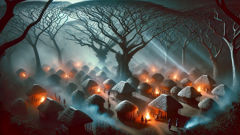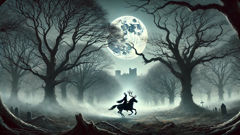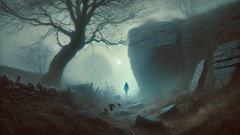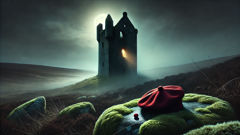Introduction
Long before the first European ships brushed the Gold Coast, and before cities grew from the earth’s red clay, the forests of Ashanti pulsed with secrets. Here, between ancient silk cotton trees and curling tendrils of mist, villagers built their homes in harmony with nature, guided by spirits and tradition. The night held a language of its own—the chirr of crickets, the songs of frogs after rainfall, and the breath of wind swirling stories through leaf and shadow. Yet, not all stories were told for comfort. Some, whispered only by firelight, warned of dangers as old as the land itself. Among these, none chilled the blood like the tale of the Obayifo—a being neither fully human nor beast, moving on the edge of vision, feeding on life and hope. For generations, mothers watched their children closely after dark, and elders scattered protective charms at doorways, for the Obayifo was said to wander freely when the moon waxed fat and orange. It was a time when magic and fear walked hand in hand, and every rustle in the undergrowth could spell disaster. In this world lived Adwoa, a young woman born under the new moon, her fate forever intertwined with the legend that haunted her village. Adwoa’s spirit burned with curiosity and courage. She loved the forest’s mysteries and respected the elders’ tales, but deep down, she couldn’t help but question whether the Obayifo was real or simply a story to frighten children. That is, until a string of calamities—sick livestock, withered crops, and a child’s sudden illness—forced her to confront the truth. The villagers’ unease grew as shadows deepened and fires burned longer into the night. The air itself seemed to thicken with ancient dread. Against this backdrop, Adwoa would embark on a journey into the heart of darkness, uncovering secrets woven into the very soil beneath her feet. Her courage—and the fate of her people—would be tested by forces both human and supernatural, echoing the eternal struggle between light and shadow.
Whispers in the Night
The first sign came on a night heavy with the scent of impending rain. Adwoa was returning from the river, a clay pot balanced effortlessly on her head, when she heard the hush of hurried footsteps behind her. She turned, but only found darkness pressing in between the trees. The air was thick—almost suffocating—and the familiar night sounds had vanished, replaced by a silence that made her skin crawl. She hurried home, heart pounding, unsure if it was her imagination or if something truly followed her.

In the morning, news swept through the village like a bushfire: Kwaku, the chief’s young son, had fallen ill. His skin was cool and clammy, and his eyes rolled back as he shivered uncontrollably. The healers were baffled; their herbs had no effect, and the usual prayers seemed to drift away on the wind. The elders gathered in the meeting hut, faces etched with worry, voices low and urgent. Adwoa listened from outside, barely daring to breathe. Old Nana Serwaa, revered for her wisdom and age, spoke the words everyone dreaded: "This is the work of the Obayifo."
The villagers exchanged glances, some nodding in fearful agreement, others casting skeptical looks. Yet, deep within each heart, seeds of fear took root. Every family brought out their protective charms—amulets woven from red cloth, bowls of salt set at doorways, talismans strung with cowrie shells. Fires burned all night in every compound, their embers believed to ward off the dark spirit.
But Adwoa could not sit idle while Kwaku suffered. With her mother’s blessing, she sought out Nana Serwaa for guidance. The old woman’s hut was draped in charms and bundles of dried herbs, the air thick with incense and the faint murmur of incantations. Nana Serwaa beckoned her in, her eyes bright as stars in her wrinkled face.
"You have courage, child," she said softly. "But courage alone is not enough. The Obayifo preys on fear, jealousy, and weakness. If you wish to help, you must first understand the spirit’s nature."
Nana Serwaa explained that the Obayifo was not always born evil. Sometimes, it was a curse—a person twisted by envy or bitterness, transformed into a being that fed on the life force of others. By day, the Obayifo could seem perfectly ordinary, blending into village life, but by night it shed its human skin, slipping out to hunt. Its eyes glowed like embers, and it left behind a cold wind and shriveled footprints.
That night, Adwoa sat by Kwaku’s bedside, whispering stories and songs in hopes of soothing him. His breathing was shallow, but she caught a flicker of recognition in his eyes. As she dozed, she dreamt of a shadow gliding past her hut—its form shifting, neither man nor beast, leaving a trail of withered leaves in its wake. She woke with a start, shivering in the predawn chill.
The next day, another calamity struck—a goat found dead in its pen, drained and stiff as stone. The pattern was clear to all: the Obayifo was among them. Whispers grew to accusations. Suspicion fell on outsiders and even neighbors. Yet Adwoa could not shake the feeling that the answer was closer than anyone suspected. She resolved to watch, to listen, and to follow the clues hidden in the shadows.
On the third night, as the moon rose full and orange, Adwoa crept through the village, careful to avoid the pools of firelight. She moved like a whisper, guided by intuition and the faintest hint of movement at the edge of her vision. Near the old baobab tree—said to be the home of restless spirits—she saw a shape detach from the darkness. It glided over the ground, barely stirring the leaves. She pressed herself against the tree’s gnarled trunk, breath held, heart racing. The figure paused, and for a heartbeat, Adwoa glimpsed burning eyes and a mouth twisted in anguish.
She understood, in that moment, that the Obayifo was not only a monster—it was someone’s sorrow, someone’s secret pain. The realization filled her with a mix of dread and compassion. If she could find the source of this torment, perhaps she could end it without more suffering.
The Curse Revealed
Days blurred into restless nights as fear gripped the village. Daily life faltered; laughter faded, and even the children’s games became muted, their eyes darting to the forest edge. In the midst of this tension, Adwoa became obsessed with unraveling the mystery. She scoured the stories told by elders and listened to gossip exchanged at the riverbank. Each fragment painted a different picture—some saw the Obayifo as a spirit born from old grudges; others whispered that it could be anyone, hidden behind a mask of kindness.
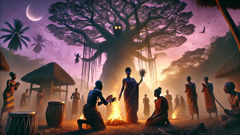
One evening, as Adwoa fetched water, she found herself beside Esi, a young widow whose gentle smile never quite reached her eyes. Esi spoke softly, her voice nearly lost beneath the wind: “Sometimes sorrow twists the soul. It can make a person unrecognizable.”
Adwoa sensed a deeper pain beneath Esi’s words. She recalled how Esi’s husband had died suddenly, how the woman often wandered alone at night. Could grief truly birth something as terrible as the Obayifo? Or was the truth more complicated still?
That night, as darkness settled and fireflies blinked between trees, Adwoa resolved to follow Esi. She kept her distance, hiding behind thickets and boulders as Esi made her way toward the old shrine at the edge of the forest. There, beneath a twisted silk cotton tree, Esi knelt and began to weep—raw, guttural sobs that shuddered through the night.
Suddenly, the air shifted. The shadows thickened, swirling around Esi’s form. Adwoa watched in terror and fascination as Esi’s outline flickered—her limbs stretching, her face contorting into something both beautiful and monstrous. For a moment, Adwoa saw two beings: the grieving woman and a dark, hungry spirit superimposed upon her. The wind carried a voice both pleading and furious: “Release me!”
Esi collapsed, spent. Adwoa rushed to her side, unsure if she would find friend or fiend. But Esi’s eyes were full of fear—not malice. “It’s inside me,” she whispered. “I never wanted this.”
Esi explained her torment: after her husband’s death, she had sought help from a traveling sorcerer who promised to ease her pain. Instead, he had bound a piece of his own darkness to her soul, cursing her to hunger for life itself. Each night, the Obayifo emerged, using her body to feed, leaving Esi drained and wracked with guilt by morning.
Adwoa’s heart ached for her friend. She realized that driving Esi away or destroying her would not end the terror—it would only transfer the suffering. They needed wisdom greater than their own.
Together, they sought Nana Serwaa’s counsel. The old woman listened without judgment. “There is always a price for tampering with grief,” she said. “But there is also hope. The bond between the Obayifo and its host can be broken—if you face your sorrow and forgive yourself.”
Nana Serwaa prepared a ritual to be performed at dawn, when the veil between worlds thinned. Adwoa gathered sacred herbs and woven charms while Esi fasted in solitude, confronting the wounds she had carried for so long. The ritual would be dangerous—if Esi’s will faltered, the Obayifo might break free and attack.
That night was the longest of Adwoa’s life. She sat with Esi beneath the silk cotton tree, watching as shadows danced and the wind keened through twisted branches. Esi wept and confessed her anger, her bitterness at fate, her guilt for surviving. Each admission seemed to sap the darkness from her form, but also left her weaker.
As dawn tinged the sky with violet and gold, Nana Serwaa arrived, robes billowing in the morning breeze. She traced sacred symbols in the earth, burned herbs that filled the clearing with pungent smoke, and chanted words older than memory. Esi trembled as the Obayifo tried to take control, but Adwoa gripped her hand, anchoring her to the world of the living.
A great wail split the air—the sound of grief and fury given form. The shadows coalesced into a monstrous shape, towering over them with eyes like burning coals and a mouth twisted in perpetual hunger. Nana Serwaa hurled a charm of salt and red cloth at its feet. “You do not belong here! Return to darkness!” she commanded.
The spirit shrieked and lunged, but could not pass the circle Nana Serwaa had drawn. Adwoa and Esi chanted together, their voices rising above the howling wind: “I forgive you. I forgive myself.”
The Obayifo faltered, its edges blurring. With a final agonized cry, it dissolved into mist, leaving only silence and the faint scent of earth after rain.
Esi collapsed, exhausted but free. The sun broke through the trees, its warmth chasing away the last traces of night.
A Village Transformed
The aftermath of the ritual lingered like the scent of rain—cleansing, but tinged with memory. The villagers gathered to hear Adwoa and Esi’s account, their skepticism slowly replaced by awe and understanding. No longer was the Obayifo merely a creature of horror; it was revealed as a warning against letting pain fester and twist the soul.
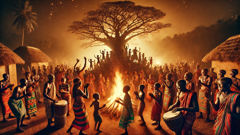
In the days that followed, Kwaku began to recover. His fever broke, his eyes brightened, and laughter slowly returned to the compound. The dead crops showed signs of life, and no more livestock were found lifeless at dawn. The elders decreed a festival of thanks—not only to honor Nana Serwaa’s wisdom but also to celebrate Esi’s courage and Adwoa’s relentless compassion.
Preparations transformed the village. Colorful cloths fluttered from rooftops; drums echoed through the trees; women wove garlands of hibiscus and marigold. As dusk fell, fires were lit in every yard, not for fear, but for celebration. Dancers painted their bodies in ash and ochre, reenacting the struggle between light and shadow through music and movement.
Esi was invited to speak before the gathering. With Adwoa beside her, she told her story—of grief, temptation, and redemption. She urged her neighbors to look for pain hiding behind smiles, to reach out before sorrow turned to poison. The villagers listened closely, moved by her honesty and vulnerability.
Adwoa, too, was changed. She saw now that monsters were often born from wounds left untended. She dedicated herself to learning more from Nana Serwaa, hoping to one day guide others who stood at the crossroads between despair and hope.
On the final night of the festival, as stars gathered overhead and music swelled in the warm air, the villagers joined hands around a great bonfire. They sang songs of courage and forgiveness, their voices rising into the night sky. Adwoa felt a weight lift from her shoulders—a sense that the old fears had loosened their grip.
From then on, the story of the Obayifo was told not just as a warning, but as a lesson: that darkness could be overcome, not through violence or exile, but through understanding and unity. In time, the village flourished again, its people bound together by threads of compassion stronger than any curse.
The silk cotton tree stood as silent witness—a living reminder that even in the heart of the deepest forest, light could find its way through.
Conclusion
The legend of the Obayifo endures in Ashanti memory—not merely as a tale of terror, but as a testament to the strength found in community and forgiveness. Where fear once ruled, understanding now takes root, teaching that darkness is part of every human heart. Yet, with compassion and courage, even the most ancient curses can be undone. Adwoa’s journey transformed not only herself but all those who witnessed her bravery. The story is shared by each new generation as a shield against despair and a beacon for those lost in grief. Under the enduring shade of the silk cotton tree, villagers remember: as long as they stand together, no shadow is too deep to overcome.

